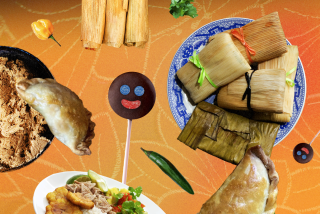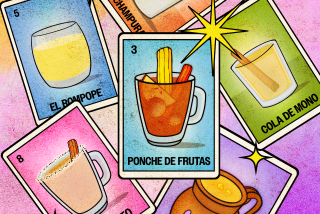How to Feed a Cold : Cinnamon, Chocolate and Lots of Sugar
Grandmothers are always eager to give advice, and mine is no exception--especially if there’s a cold to be dealt with. But it was only recently that she told me about the family cold cure, the one she thought worked best but had never used on me or my sister.
“Well,” she said, coyly, “it’s something that grown-ups used to use--especially the men.”
Ah, I was getting the picture. This was one of those boozy cures from which children (and, according to my grandmother, some delicate women) were supposed to be protected. At least, that was the attitude of her generation.
“Yes,” she confirmed, “it’s like a toddy. You take a cup of hot, strong tea, either mint or epazote , and add a good shot of whiskey and a stick of cinnamon. Cinnamon always helps.”
But, it turns out, the cure wasn’t as much fun as it sounded because it came with strict rules of behavior: “The person had to be very still,” my grandmother explained. “Blankets were piled on top of him, up to his neck. He’d just lay there real quiet. And he’d have to stay like that until he finished sweating.”
It wasn’t a pretty picture, imagining my grandfather being monitored by my grandmother for signs of sweat.
Still, I had some experience with a tamer version of the procedure. Both my mother and my grandmother were fans of the rub-down and blanket-wrap treatment for kids. Instead of clearing our systems with whiskey, we were rubbed on our backs and chests with either Mentholatum or Vick’s Vaporub--a not unpleasant experience for a sick kid looking for attention.
Sometimes, though, we’d get the mustard treatment. “You mix flour and dry mustard--three parts flour to one part mustard--with warm water and make a paste,” my grandmother reminded me. “You put the paste on a piece of flannel, fold it over and then warm it. It has to be warm--but you have to be careful because you can’t let it get too hot.”
The coated flannel went on our chests and on our backs. When it was removed we were rubbed down with olive oil and covered with another clean piece of flannel. “It was really very effective,” my grandmother said.
But it wasn’t much fun either--the paste was always a little too hot--and what’s more, you ended up feeling like a human salad.
My favorite grandmother remedies were not the foods that went on our bodies, but the food we got to eat.
Of course, both my mother and my grandmother made chicken soup, which for some reason I loved to eat with a banana when I was sick. I also liked fideo , coiled angel hair pasta that was fried in oil, then simmered in chicken broth with tomatoes and onion. Even better was my grandmother’s rice pudding, which made me feel good, even when I wasn’t sick.
My grandmother’s own favorite sick food, to soothe an upset stomach, is champurrado , a chocolate-flavored atole . “You know,” she told me, “whenever your mother had a tummy ache, I’d make an atole for her.”
Atoles are usually made with masa , the corn mush that makes tortillas and tamales. The masa is mixed with water and stirred over a hot stove until it’s silky-smooth. Sometimes, when she was out of masa , my grandmother would make atole from Quaker Oats. “You let the oats soak in water, then you mash them with your hand and then mash them again and drain them in a sieve. You want to squeeze out all the nutrients--the good stuff.”
She’d heat the liquid with a stick or two of cinnamon and maybe some milk until the whole thing thickened. Then she’d add some sugar, heat the mixture a little more and serve it hot.
Other atoles may be fancier, flavored with pineapple or blueberries or vanilla, even simmered with black beans. But my grandmother almost always goes for the chocolate. After all, she says, when you’re taking care of someone who doesn’t feel well, your job is to try to keep the person warm and in bed. And what could make staying in bed sweeter than a cup of hot champurrado ?
My grandmother, like many grandmothers, rarely cooks from recipes--she just cooks. Diana Kennedy’s “The Cuisines of Mexico,” however, contains a champurrado recipe that comes close to my grandmother’s. Of course, she would use piloncillo--the dark, unrefined sugar sold in cones at most Mexican markets--instead of boxed brown sugar. And she’d toss in an extra stick or two of cinnamon and an extra tablet of chocolate. To my grandmother, more is better.
She also warns, if you’re running a fever, replace the warm milk with warm water.
CHAMPURRADO 1/2 cup prepared tortilla masa or 1/2 cup masa harina mixed with 1/3 cup water 2/3 cup water 1 1/2 cups warm milk 1 1/2 cups warm water 1 (1 1/2-ounce) tablet Mexican chocolate, broken into pieces 1 (3-inch) cinnamon stick 3 tablespoons brown sugar
Place masa and 2/3 cup water in saucepan. Cook over low heat, stirring constantly, until masa thickens, about 5 minutes. Gradually stir in warm milk and warm water and cook until mixture begins to bubble. Add chocolate, cinnamon stick and brown sugar and cook slowly, stirring, until mixture thickens, about 15 minutes. Makes 3 servings.
More to Read
Eat your way across L.A.
Get our weekly Tasting Notes newsletter for reviews, news and more.
You may occasionally receive promotional content from the Los Angeles Times.











